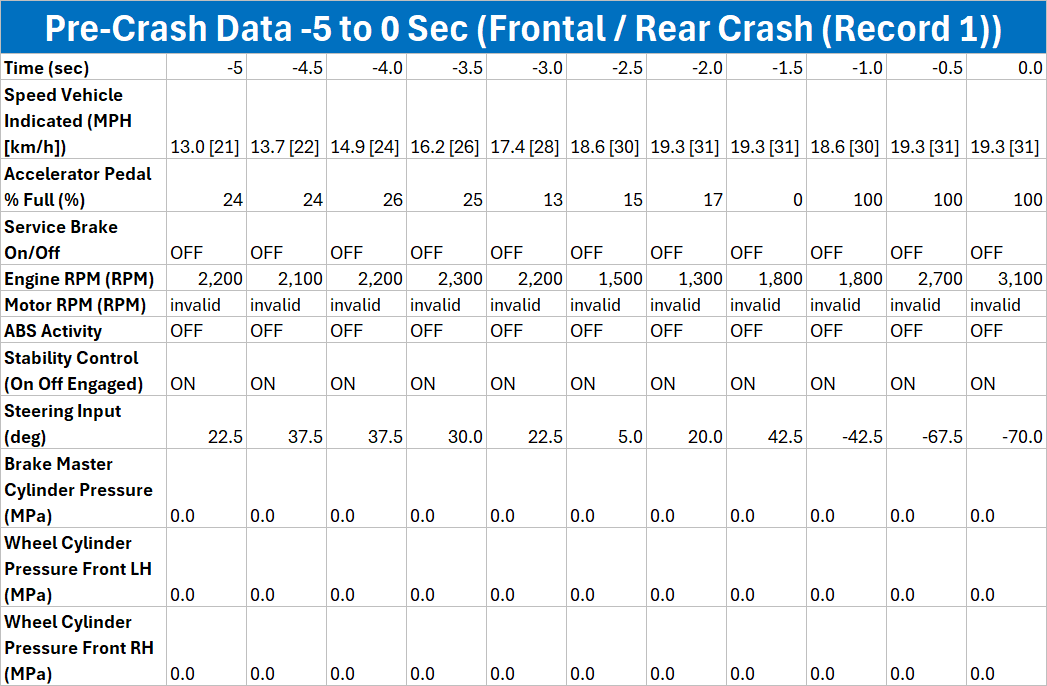How Black Box Data Shapes Car Accident Analysis
After a car accident, people may give different accounts of what happened. Your attorney’s job is to investigate, uncover the truth, and build the strongest case possible on your behalf. One powerful and objective piece of evidence your attorney can collect is black box data.
In one case handled by our firm, our client was injured in a head-on collision with another vehicle. The defendant driver claimed her brakes didn’t work and the steering wheel cut to the left on its own. Upon inspection, our engineers couldn’t find anything wrong with the car. What’s more, the black box data revealed that the driver was going faster than she claimed, and, crucially, she stepped on the gas instead of the brake in the seconds before the accident. The data, pictured below, was undeniable: it proved the defendant was, in fact, responsible for the accident.
Though black box data was a smoking gun in the above case, our attorneys have handled many lawsuits where it was just one piece of the puzzle — after all, most of the time, no single piece of evidence reveals every aspect of a car accident. Below, we break down what black box data reveals, how to get it, and how it has helped us secure significant results for our clients.
Need to Know:
- Also known as event data recorders (EDRs), black boxes are crash-resistant devices that record information about speed, braking and more from the seconds before, during and after an accident.
- Your attorney will need to hire an expert to extract and analyze the black box data. Finding the right expert is essential, as black box technology has evolved over time and there are also variations among car manufacturers.
- Virtually all vehicles manufactured since 2014 have black boxes.
In This Article:
- Critical Information Derived From Black Box Data
- The Process of Acquiring Black Box Data
- How Black Box Data Can Strengthen Your Case
- $8 Million Settlement: How Black Box Data Proved Crucial to Our Case
Critical Information Derived From Black Box Data
While a black box is constantly recording, it has very little memory and is always overwriting data, unless a sudden extreme deceleration or the use of airbags triggers it to save.
According to Section 563.7 of the Code of Federal Regulations, vehicles equipped with EDRs must record multiple data points, such as:
- Speed
- Acceleration
- Steering input
- Service brake, on/off
- Safety belt status, driver
- Frontal air bag deployment
- Engine rpm
- Vehicle roll angle
- ABS activity
Most commercial trucks also have a different type of black box known as an electric logging device (ELD). Unlike EDRs, ELDs track data such as trip times and total idle time, and usually convey this information to the company via satellite. In commercial truck accident cases, ELD records are often consulted for an important data point: consecutive driving time. If a commercial truck driver breaks federal laws regulating the maximum number of hours they can be behind the wheel, that is a clear case of negligence.
Even in cases where we have surveillance footage, dashcam footage, and witness testimony, our attorneys still seek black box data, if available. No other form of evidence can objectively state 1) how fast a vehicle was moving or 2) whether the driver tried to brake – critical data points when proving negligence.
The Process of Acquiring Black Box Data
In rare instances, a vehicle can be damaged badly enough that the black box is destroyed. Our attorneys have also handled cases where the black box was malfunctioning and did not record any data.
However, if the black box was recovered and working properly, then it’s well worth the effort of retrieving.
Legal Statutes Regarding Event Data Recorders
Currently, less than half of U.S. states have laws specific to black box data. States that do have such laws, including New York, largely focus on regulating privacy and access to the data.
In New York State, Vehicle & Traffic Law Section 416-B outlines the scenarios in which black box data may be downloaded. If the owner or legal representative of a vehicle does not consent to data retrieval, then your lawyer will need a court order to obtain the data.
We have found that defendants who are resistant to producing black box data usually know its analysis will not be in their favor. In cases like these, getting a court order has generally been very advantageous in securing a fair settlement.
Hiring Experts
Though the devices themselves are common, black box technology is far from universal. Depending on the age and make of a vehicle, there can be variations in how its black box must be extracted and the software needed to analyze the data. Sometimes, a much older black box will still record event data perfectly — but finding someone who knows how to extract and analyze that data can be a challenge.
When hiring a black box data expert, we look for someone who is up to that challenge, regardless of the technology involved. Our attorneys also consider how well he or she would perform in front of a jury, if necessary. Sometimes, our attorneys will hire an expert who has previously testified for the defense: this goes a long way in establishing credibility and impartiality.
Following Chain of Custody
If black box data is to be admissible in court, it must follow a strict chain of custody demonstrating that the evidence came from the defendant’s vehicle and was not tampered with.
To ensure this, one of our attorneys and the defense attorney will accompany their respective EDR experts to the vehicle in question. At this meeting, the experts will download the data directly from the vehicle. This process confirms to the court that the data meets reliability and admissibility standards to come into the case as evidence.
How Black Box Data Can Strengthen Your Case
Most car accident lawsuits are negligence cases. This means your attorney must prove, among other points, that the defendant did not exercise reasonable care. Presenting proof that the defendant was speeding, or did not brake or take other measures to avoid an accident, can draw a clear connection between the defendant’s actions and your injuries.
Often, our attorneys use black box data with other forms of evidence to overwhelmingly demonstrate that the defendant was negligent.
In one case that Block O’Toole and Murphy handled, our client was driving on a highway when he was struck from behind by another car. The defendant claimed our client was switching lanes directly in front of him, cutting him off and leaving him unable to avoid a collision. However, our client was driving a Tesla, which is equipped with dashcams in all four corners of the car. The footage proved our client was driving at a consistent speed and not switching lanes at the time of the accident: the defendant had come up and hit him from behind.
What’s more, while the defendant initially claimed he wasn’t speeding, black box data from the defendant’s car showed he was driving 20mph over the speed limit. Together with the camera footage, this clearly demonstrated that the defendant was liable for the accident.
$8 Million Settlement: How Black Box Data Proved Crucial to Our Case
In one case handled by partners Jeffrey A. Block and S. Joseph Donahue, a 64-year-old man was hit by an NYC Transit Authority bus as it was making a right-hand turn. Our client had begun crossing the street outside of a crosswalk and was almost halfway across the street when he was struck by the bus’s front passenger door.
He was knocked to the ground and the bus’s rear tires ran over his legs, resulting in multiple fractures in his left leg and the traumatic amputation of his right leg. The driver claimed he did not see our client before the impact.
This was not a clear-cut case. Our client was wearing dark clothing in a dimly lit area at night, and though he had a walk signal, he was approximately 30 feet outside the crosswalk. The defense argued that all of these factors made it unreasonable for the bus driver to have seen our client.
However, through their early investigation, our attorneys were able to secure a surveillance video that told the other side of the story. The bus driver had made the turn at a dangerously high speed, causing him to lose control of the bus and cross the double-yellow line into the lane of oncoming traffic. In his effort to avoid a head-on collision, the driver failed to notice our client. Donahue argued that the video showed the bus driver should have seen our client, but he was too distracted by correcting his own error to do so.
To further establish our case, Donahue had the bus driver testify under oath that any turn in excess of 10mph would be reckless. The black box data showed the driver made the turn at 14.9mph, demonstrating the driver had been careless — and he knew it.
Thanks to the combined evidence of the video and the black box data, our attorneys were able to secure our client a settlement of $8 million.
Contact an Experienced Car Accident Lawyer
The lawyers at Block O’Toole and Murphy take nothing for granted: we hire the best black box data experts to analyze your accident and support your case. Our strategies have led us to multiple record-breaking settlements, including a $22,500,000 settlement for a car accident victim in Westchester.
If you or a loved one was in a car accident, give your case the best chance of success by hiring an experienced auto injury attorney. We know how to use every piece of evidence possible to build your case and fight for the compensation you deserve. Schedule your free legal consultation by calling 212-736-5300, or by filling out our online contact form.


